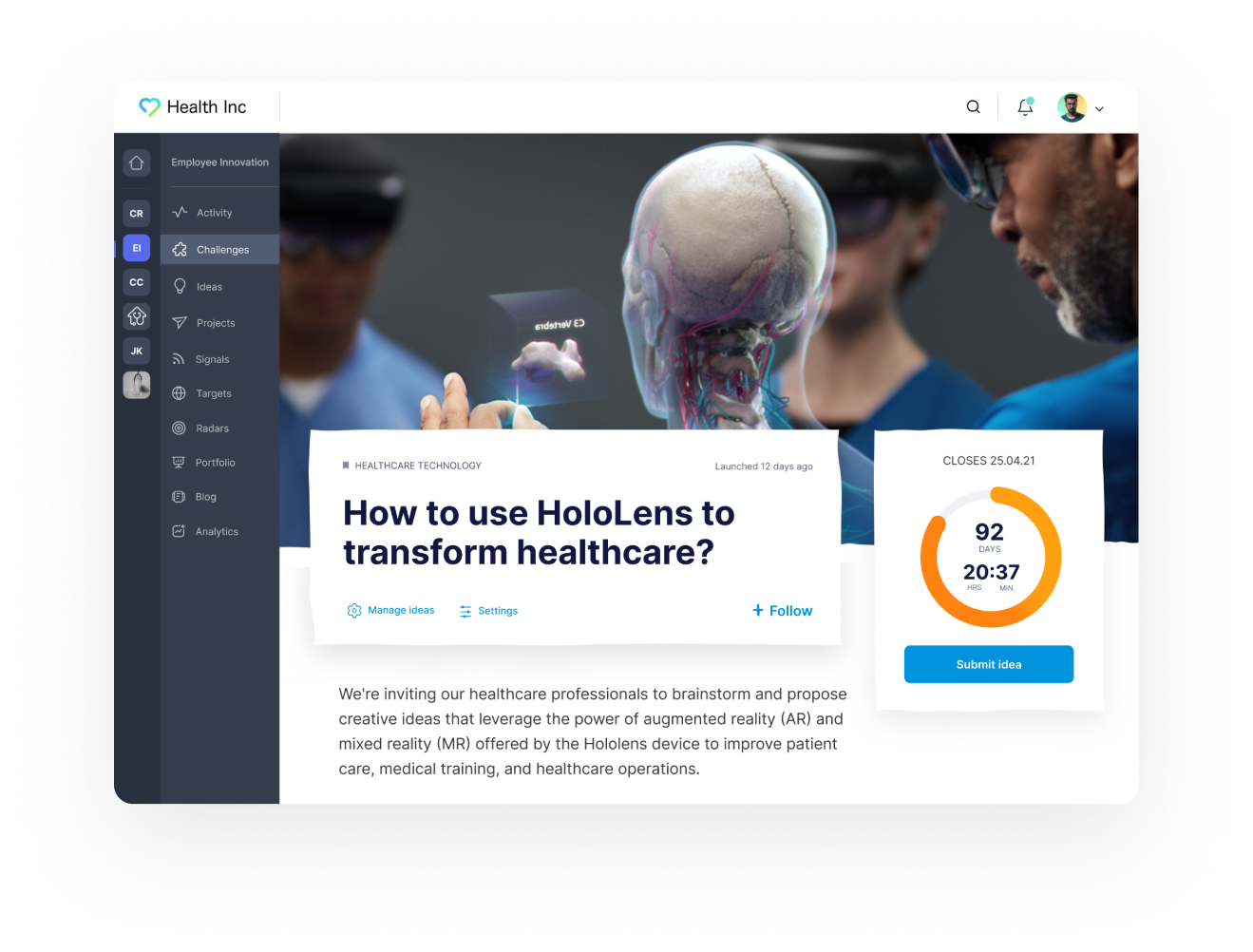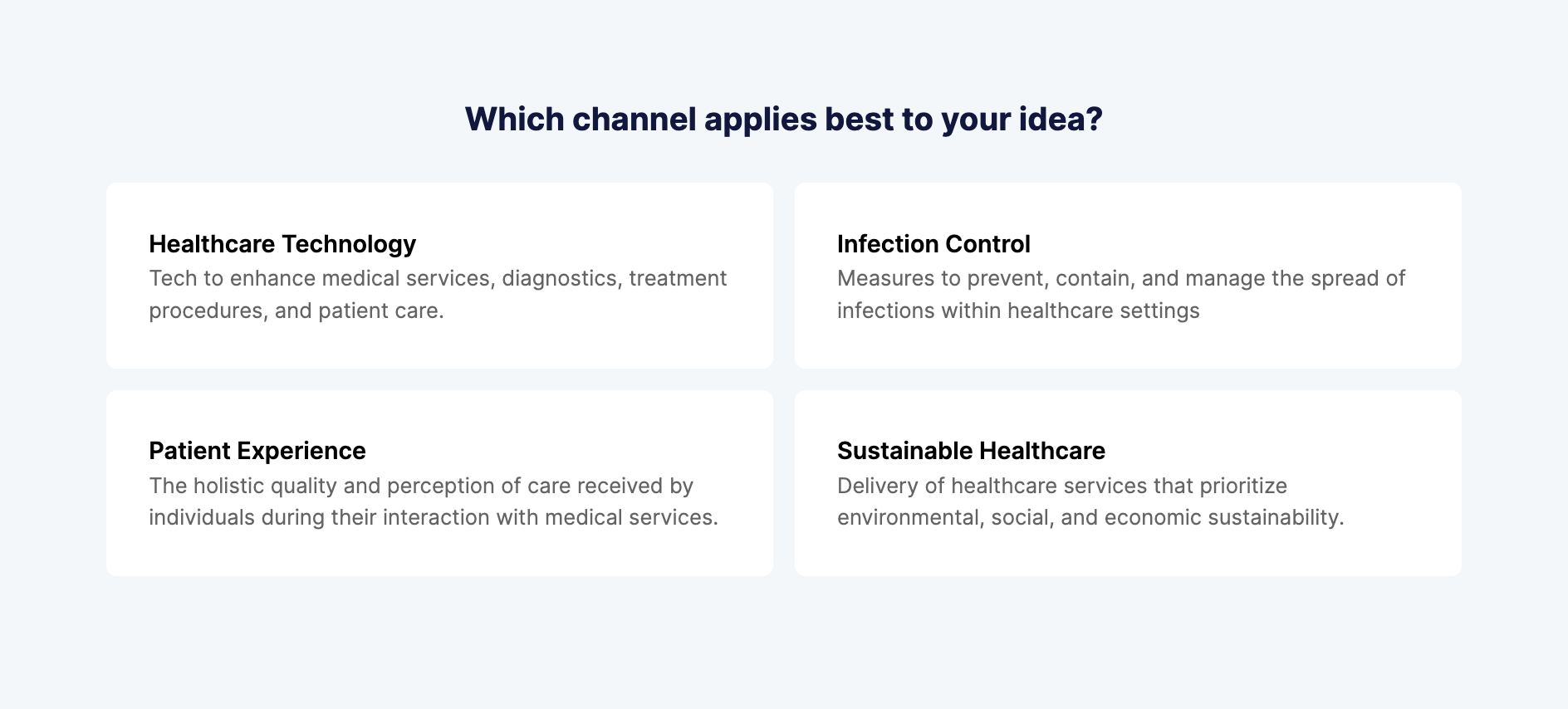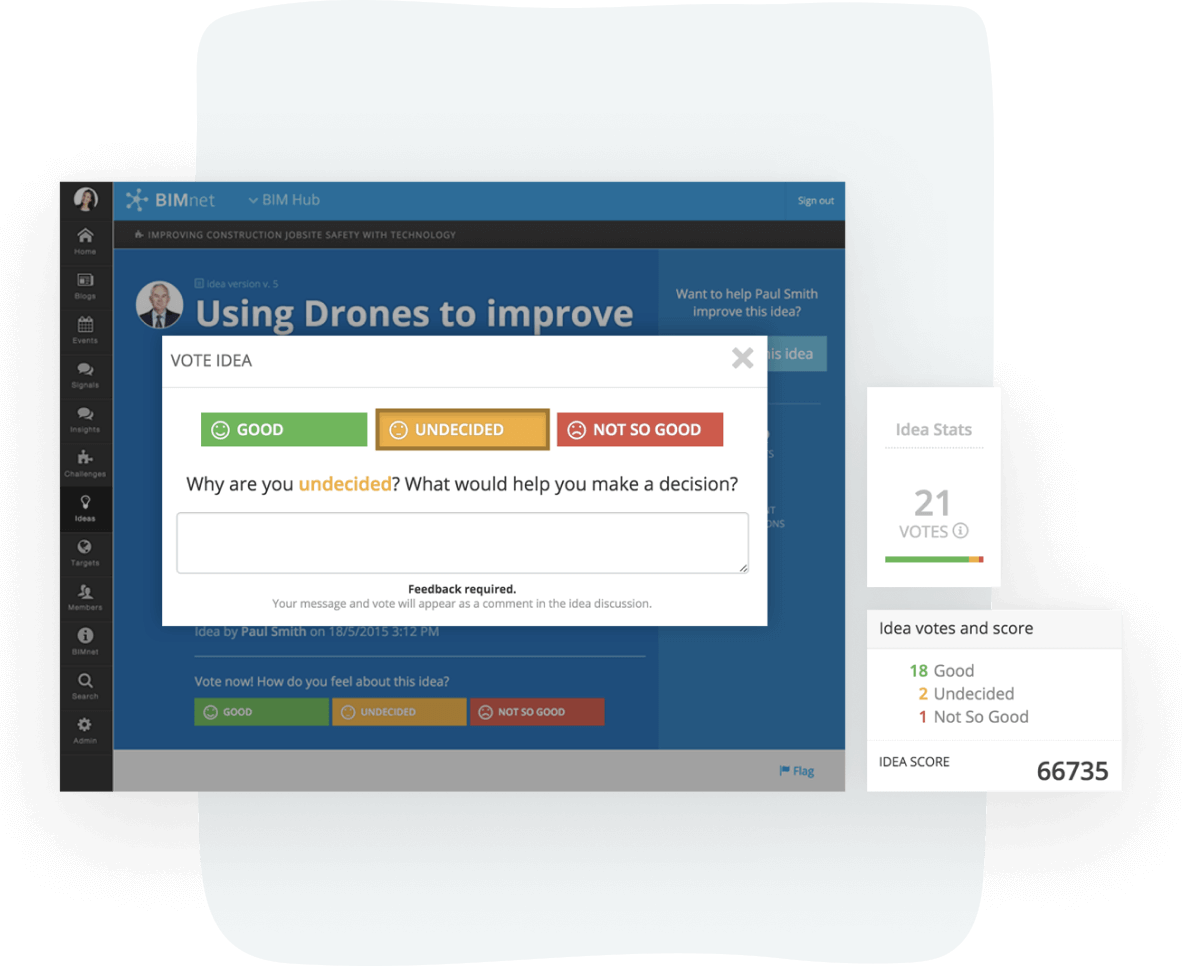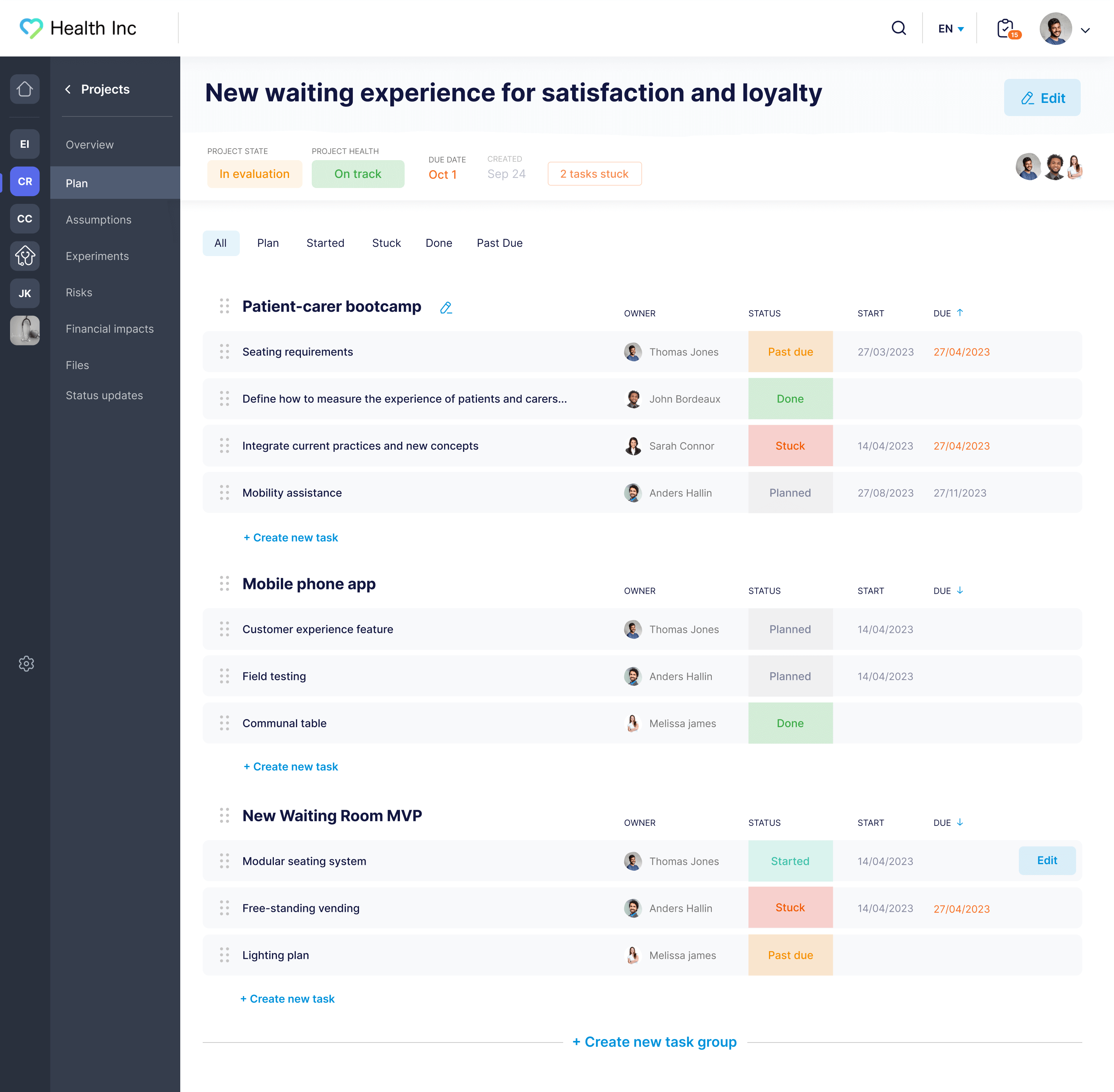Idea management is a structured approach to collecting ideas and transforming them into products and processes that benefit the organization.
The idea management process can be broken down into six key stages:
Idea Generation — Innovation managers inform employees and outside participants about the organization’s priorities, inviting them to share ideas aligned with those goals.
Idea Improvement — Innovation managers provide employees with access to one another's ideas, encouraging collaboration. By discussing potential weaknesses and suggesting improvements, they help refine each other's concepts.
Idea Evaluation — After ideas have been enhanced through collective input, innovation managers pass them on to relevant leaders and experts for evaluation.
Idea Prioritization — Even if many viable ideas are available, organizations rarely have the resources to pursue all of them. Innovation managers, in collaboration with stakeholders and decision-makers, rank ideas based on impact, feasibility, and alignment with organizational goals.
Idea Testing and Validation — High-potential but uncertain ideas require validation. Innovation managers help teams plan experiments to test these ideas before full implementation. For instance, a product team might develop an MVP (minimum viable product) and gather user feedback through the customer success team.
Impact Tracking — Once an idea is implemented, organizations use KPIs to measure success and ensure it delivers the expected impact.
In our experience, even companies with a defined innovation strategy and clear innovation values often fail to manage ideas thoroughly enough. In other words, they don’t intentionally implement each step of the idea management process. Without this complete set of steps, the idea-to-implementation process tends to stall.
For example, some common issues we’ve encountered include:
Employees don’t know the organization’s highest priorities. Instead of informing them of current priorities and soliciting relevant ideas, employees are left to submit any ideas that come to mind — many of which may be irrelevant to the organization’s immediate needs.
A few innovation managers handle all idea submissions. Instead of empowering each department to manage its own local ideas, this centralized approach often leaves many potentially impactful ideas untouched due to time constraints and a lack of department-specific business knowledge.
Little focus is given to idea feedback and improvement. Employees submit ideas, but they rarely receive insight into what happens next, leading to frustration and reduced employee engagement.
Below, we’ll explore how to implement an effective idea management process — one that actively develops ideas into products, services, and processes, rather than collecting dust in a spreadsheet.
Step 1: Collect Ideas Related to the Organization’s Priorities
During the idea-collection stage, innovation managers aim to gather high-quality ideas aligned with the organization’s priorities. A common method is to use a company email address or web form to solicit ideas from employees and external user groups.
However, this “digital suggestion box” approach has a limitation: Employees often don't understand the innovation department's priorities or the types of ideas needed. As a result, they may submit ideas that are irrelevant to the organization's innovation strategy.
For instance, if a tech company identifies AI features from competitors as a significant threat and seeks ideas to address this, employees are unlikely to submit relevant ideas if they are unaware of this priority.
To overcome this, organizations should first educate employees and external participants about their goals and priorities. One effective approach is to create Innovation Challenges, which clarify the organization’s focus and encourage the submission of relevant ideas.
Run Innovation Challenges
Innovation Challenges are invitations for employees to submit ideas related to specific priorities, with a deadline for submissions.
Within each challenge posting, innovation managers should include the following information:
Context and background: Explain why the challenge is important.
Evaluation criteria: Provide clear criteria for how ideas will be evaluated and selected.
Restrictions: Outline constraints such as implementation time and costs.
Value and impact: Describe who will benefit from solving the challenge and the value and impact expected.
Next steps: Explain what will happen to the ideas selected for further development.
This approach ensures that participants understand the types of ideas the challenge sponsors and innovation managers are seeking — whether it’s ideas on breaking into a new market, reducing customer churn, or improving the product line. As a result, employees will submit ideas that are directly relevant to the challenge topics.
Because challenges are time-constrained, everyone is encouraged to participate before the deadline. This makes innovation challenges an effective method for innovation departments that need ideas quickly.
How InnovationCast Supports Targeted Idea Collection
InnovationCast offers two features that align with the best practices for idea collection:
Innovation Challenges: Collect ideas before a specific deadline.
Category-based “Always On” Idea Collection: Allow users to submit relevant ideas at any time.
Innovation managers can use Innovation Challenges to educate users about the organization’s priorities by attaching resources like presentations, research papers, press releases, videos, and FAQs. This ensures that users have a deep understanding of the priorities before submitting ideas.

In addition, since challenges have deadlines, users are prompted to submit ideas quickly, helping innovation managers collect ideas within a short timeframe.
With our category-based “Always On” feature, innovation managers can set up areas of interest that tell employees what types of ideas they’re looking for. Employees can then submit ideas related to these categories 24/7.

Innovation managers can also create custom idea submission forms for each category of ideas. These forms contain questions specific to the priority, encouraging employees to share why they believe their idea should be implemented, the value they can deliver to the end user, and any roadblocks implementation teams may face during launch.

Read more: 7 Strategies to Get Innovative Ideas from Employees
Step 2: Improve Ideas Using All Team Members' Skill Sets
Once innovation managers have collected ideas, we’ve found it’s most effective if the company encourages employees to review each other’s ideas and suggest improvements.
This crowdsourcing step gets more collective brainpower reviewing ideas instead of just a few managers being asked to review all submissions. We’ve seen organizations that do this end up with vibrant discussions between employees, refining and improving submitted ideas. Plus, getting employees from different parts of the organization (legal, marketing, engineering, manufacturing, etc.) brings a lot of cross-functional expertise into these discussions.
Note that some organizations try to implement this advice halfway by asking employees to vote on each idea. While this is a step in the right direction, in our experience, a simple thumbs-up or thumbs-down lacks the impact of qualitative written feedback. Ideas aren’t a popularity contest. The value lies not in identifying the most popular ideas but in leveraging the collective insight of the organization to develop the best ideas.
How InnovationCast Supports Idea Improvement
When a user submits an idea, their colleagues can view it on their InnovationCast activity stream or receive a notification, depending on their preferences.

Users can provide feedback on an idea by choosing "Looks good," "Not so good," or "Undecided" if they need more information.
Most importantly, InnovationCast prompts users to explain their opinion, detailing why they believe the idea is good or not so good.

The original idea author is notified of the feedback and can respond to the voters. This collaborative approach allows everyone to leverage their skills to identify potential constraints, make recommendations, and iterate upon the idea.
Step 3: Evaluate Ideas and Select the Best Ones
Once innovation managers have informed employees about the innovation strategy, asked them to submit ideas, and encouraged everyone to improve upon them, they should be left with a list of high-quality ideas relevant to their priorities.
During idea evaluation, the goal is to analyze the feasibility, value, and risk associated with each idea and decide which to validate and implement.
However, the process we see in many companies is that all ideas are submitted to the innovation department, and just a few innovation managers are responsible for evaluating all of the ideas.
This approach presents two problems:
Innovation managers don’t have time to evaluate every single idea: It’s unlikely that three or four innovation managers can evaluate thousands of ideas.
Innovation managers lack the know-how to evaluate ideas across all topics: Employees and outside participants are submitting ideas relating to fields such as marketing, product development, legal, HR, finance, and R&D. Innovation managers don’t have the necessary expertise in each of these fields to know which ideas have potential.
Allow Each Department to Manage “Local” Ideas
Instead of having the innovation team manage all idea submissions, we recommend delegating idea evaluation to individual departments so they are responsible for their own “local” ideas.
Innovation managers can support departments by helping them develop an innovation strategy, create evaluation criteria, set up the idea management platform, and organize idea collection activities such as hackathons, brainstorming sessions, and challenges.
For instance, if an IT specialist proposes a new system that can boost productivity by 20%, IT managers should evaluate whether to pursue or discard the idea. This ensures that the right expertise is applied to each idea — IT managers assess IT-related ideas, marketing managers evaluate marketing ideas, and so on.
Enabling each department to manage its own ideas frees up innovation managers’ time to evaluate and validate transformative ideas — those with high uncertainty and high potential returns that can significantly impact the organization in the long run.
Use Evaluation Models and Scorecards
The method used to evaluate ideas depends on the level of uncertainty risk involved. For ideas with low risk and high certainty — such as adopting a new internal communication tool to improve collaboration — innovation managers can use idea evaluation models.
An idea evaluation model is essentially a set of questions that decision-makers answer to assess an idea's potential impact, level of risk, and relevance to the organization's goals. This helps department leaders understand which ideas to pursue.
For example, the RICE framework is commonly used for low-risk, high certainty ideas:
Reach: How many people can this idea impact?
Impact: What impact can this idea have on the company?
Confidence: How confident are you in executing this idea?
Effort: How much effort is required to execute this idea?
For ideas with higher risk and uncertainty — such as entering an unproven market or adopting a new business model — department leaders should use the scorecard approach.
Each scorecard contains a list of assumptions or criteria that an idea has to meet in order to be considered successful. These assumptions may be about an idea's risk level, impact on the company, or strategic fit and priority. Then, department leaders assign scorecards to team members who perform certain tasks to prove or disprove these assumptions.
This allows department leaders to understand which ideas have the most potential and lowers uncertainty to an acceptable amount of risk aligned with the company’s growth appetite.
Read more: Best Practices to Evaluate Innovation Ideas
How InnovationCast Supports Idea Evaluation
We designed InnovationCast with configurable idea evaluation workflows that innovation managers can use to evaluate various types of ideas. These workflows are like roadmaps containing tasks and criteria that help organizations decide whether to move an idea forward.
Depending on the type of idea, these tasks may include building a business case, conducting a financial risk assessment, or developing a market feasibility study.

We offer idea-specific workflows tailored for continuous improvement ideas, product ideas, business model ideas, operational ideas, and more.
Within these workflows, department leaders can invite teams to complete tasks and set deadlines. They can monitor progress, identify delays, and, if necessary, reassign tasks or call on other teams to share the workload.
Additionally, users can customize our workflows to align with their organization's processes. They can rearrange tasks by dragging and dropping steps and add or remove steps as needed without contacting our customer support team (though we assist with setup during onboarding).
Step 4: Have Stakeholders Vote on the Order in Which to Launch Ideas
Even though decision-makers have filtered out flawed ideas and are left with a shortlist of promising ones, it’s important to remember that the organization is unlikely to have the time and resources to validate and implement all ideas simultaneously.
Some ideas will be more promising and align better with organizational priorities.
This is where the idea prioritization step comes in.
How InnovationCast Facilitates Idea Prioritization
InnovationCast has features that allow managers to invite key stakeholders to vote on which ideas to implement.
When selected users log into InnovationCast, they can see all assessed ideas, analyze each idea's potential impact on the company (using the knowledge gathered in step three), and vote on which ideas are “winners” and “runners-up.”
Step 5: Run Experiments to Validate Ideas
After crowdsourcing feedback and having department leaders evaluate ideas, the most promising ideas proceed through idea development workflows for validation.
Ideas with low risk and high certainty — such as small changes to existing products and processes — typically skip this validation step. These ideas are supported by existing data, and their failure won’t significantly impact the organization. They usually move directly into planning, resource allocation, or even implementation.
However, potentially transformative ideas involving high uncertainty and risk, such as targeting a new customer segment or testing a new business model, require more extensive validation.
Validation steps can vary depending on the type of idea. Continuous improvement ideas, new product ideas, operation process ideas, and business model ideas each have specific validation methods. These might include detailed market research for new product ideas or small-scale pilot rollouts for improvements in employee experience.
How InnovationCast Supports Innovation Projects
To help innovation managers keep validation processes on track, we added a project management feature within InnovationCast.
Innovation managers can create validation tasks to assess whether an idea is worth pursuing and invite teams, both inside or outside the organization, to complete these tasks.
Innovation managers can then add information and resources to these task cards that validation teams need to know before completing them, such as field testing data, design specifications, or regulatory requirements.
Validation teams can comment inside task cards, notify innovation managers if they require more information, provide updates on their progress, and report on any issues they encounter.
For instance, in the screenshot below, you can see an organization validating a patient-carer bootcamp, a mobile application, and new waiting room MVP.

For each validation task, innovation managers can track the responsible team members, start and due dates, and the status of each task — whether it’s on track, planned, past due, or the team is encountering issues.
Step 6: Measure the Impact of Each Project
We found that it’s essential for innovation managers to measure performance metrics and report on the impact each project is having on the organization. This allows them to tell which ideas are most successful, which ones aren’t living up to expectations, and which ones to discard.
Although the KPIs you use depend on the idea you've launched, innovation managers typically measure the impact of projects by running customer surveys, tracking sales figures and adoption rates, or gathering customer feedback. Innovation managers then use this information to guide future innovation initiatives.
Read more: How to Measure Innovation: Essential KPIs & Best Practices
How InnovationCast Supports Impact Tracking
InnovationCast includes portfolio management and reporting dashboards to help organizations measure the impact of their innovations:
Portfolio management: Organizations can track ideas, assess which ones have generated value and which have fallen short, analyze the reasons behind these outcomes, and use this information to improve future innovation efforts.
Reporting dashboards: Organizations can create customized dashboards or integrate with Power BI to monitor key metrics such as the number of active projects, total user engagement, revenue generated by projects, and more.
Centralize the Idea Management Process with InnovationCast
An effective innovation management process helps collect high-quality ideas related to organizational priorities and develop them into valuable products, services, and processes.
While it’s possible to manage ideas usings separate tools — such as survey tools for the ideation process, idea management software for organization, and project management tools for implementing ideas — this can cause two problems:
Ideas can get lost and become unorganized: When teams need to export ideas into different tools, it can disrupt the innovation process and cause valuable ideas to be overlooked.
Employees may lose track of their ideas: Without a centralized idea management system, employees may not know what happens to their submissions, which can reduce employee engagement and increase the likelihood of them disengaging from the innovation process.
That’s why we created InnovationCast. Our platform centralizes the entire innovation management process in one hub, from idea collection and improvement to assessment, validation, and implementation.
Book a demo with our team to see how InnovationCast can enhance your innovation management.
Related reads:

